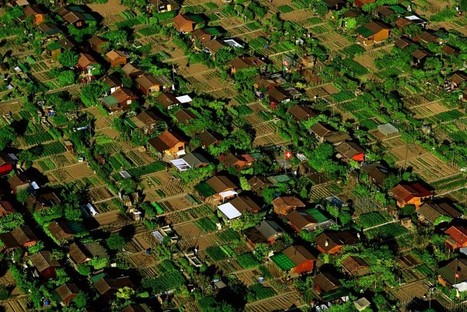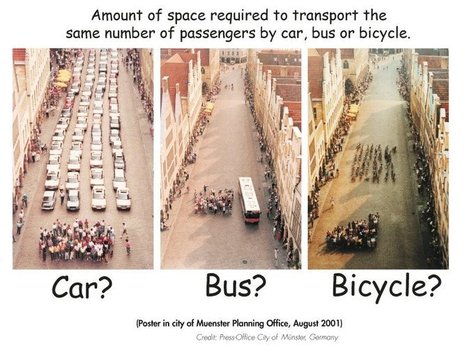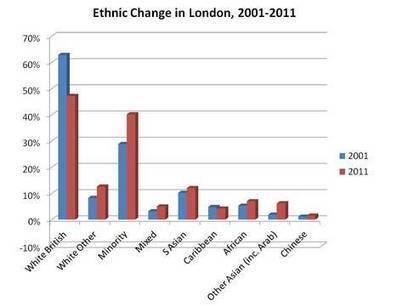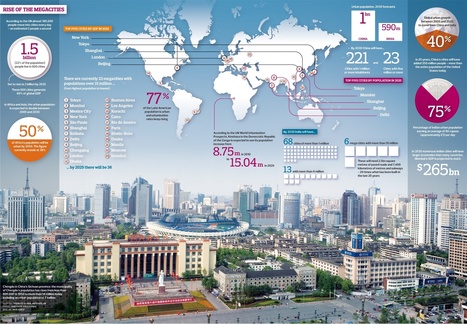What if you put all 7 billion humans into one city, a city as dense as New York, with its towers and skyscrapers? How big would that 7 billion-sized city be? As big as New Jersey? Texas? Bigger? Are cities protecting wild spaces on the planet?
Get Started for FREE
Sign up with Facebook Sign up with X
I don't have a Facebook or a X account
 Your new post is loading... Your new post is loading...
 Your new post is loading... Your new post is loading...

Kaitlin Young's curator insight,
September 17, 2014 12:10 PM
In a time where more people are moving away from their rural roots to try and make it big in the city, I think it's becoming more and more important that we focus on how to utilize our urban surroundings in a beneficial way. These photos are proof that it is possible, and I believe that cities in the United States should be more open to urban farming. It could be a way to not only take pressure off of families in cities trying to feed their children, but will also educate all sorts of people on where food comes from, and the importance of the environment. 
Maria la del Varrio's curator insight,
December 13, 2014 3:16 PM
Urban agriculture is a reality in third world countries. In Dominican Republic almost everyone in the country side have its own land to plant necessary food and fruits. The most popular is plantain and fruit is orange. In urban areas is rare to see this, so is surprising to see how central Asians are doing it.
BrianCaldwell7's curator insight,
March 16, 2016 3:58 PM
I love Yann Arthus-Bertrand's photography; so many of them are geography lessons in and of themselves as he captures compelling images of the cultural landscape. This particular gallery shows 32 stunning images including this one above showing urban agriculture in Geneva, Switzerland.
Tags: agriculture, food, landscape, images, urban, unit 5 agriculture, unit 7 cities.

Jess Deady's curator insight,
May 4, 2014 8:50 PM
To be a megacity like this, you have to conform to urbanization. There is no possible way to have such a populated and crowed city with farmlands around. This is a place of business yet residential areas, it also is where the marketplaces are and where kids go to school. Megacities need to be a part of an urban society in order for them to stay afloat. 
Bec Seeto's curator insight,
October 30, 2014 6:07 PM
This is a great introduction to the demographic explosion of the slums within megacities. This is applicable to many themes within geography. 
Sarah Cannon's curator insight,
December 14, 2015 10:20 AM
I can't image or even relate to the experience of living in a place like this. With rivers polluted right outside your house. And those rivers are what people bathe in and wash their clothes. I can't imagine not being able to access clean drinking water or lacking food. The people in Dhaka endure so much their whole lives, a good percentage of them will always live in poverty. |

Sierra_Mcswagger's curator insight,
September 10, 2014 10:02 AM
This video is primarily talking on the widely known topic of migration. 3 percent of the worlds population is living away from there place of birth. The push of migration from places include poverty, war, and environmental disasters. The migration pull in some places are because of economic opportunity, and political freedom. Migration is increasing, and is thought of as a bad thing.(s.s.) 
Aurora Rider's curator insight,
October 7, 2014 8:59 PM
This video is great for going over the many different aspects that go along with migration. It talks about what migration is and the reasons why people migrate known as push and pull factors. It talks about the different types of migration such as asylum seakers and illegal immigration. It mentions the disadvantages and advantages of migration.
Katelyn Sesny's curator insight,
October 31, 2014 12:27 PM
A great YouTube video- discussing the controversy of international migration among other things that fall into place of the disapproval of international migration. -UNIT 2

Joseph Thacker 's curator insight,
April 15, 2014 5:57 PM
Wow, I cannot imagine living in these conditions. It looks smaller than a prison cell; only people pay to live there. These extreme living conditions are a result of over population in an area. It seems the city of Hong Kong is running out of places to build and house the abundance of people living there. It appears the average person in Hong Kong lives in these conditions due to the high price tags on larger apartments. This is a sad reality. 
Jess Deady's curator insight,
May 1, 2014 11:06 AM
Living in such close quarters must be incredibly hard to do for those people who are new to Hong Kong and know something different. For Chinese residents, this is normal. Living in such small areas is a part of the Chinese daily life and culture. China is so population dense that this is the result of living there, tiny living spaces.
James Hobson's curator insight,
October 6, 2014 3:47 PM
(in-class 4: Hong Kong) What I take away from this is the theme of supply and demand. Though these condiions seem stereotypically negative, it seems like those who live in the photographed homes are relatvely well off (food, TV, clothing, etc.). This supports the view that living in these tight conditions is less of a choice and more of something that has to be put up with. Now that Hong Kong has been developed 'across', it'd be a good guess to say that recently investments have been made to build 'up' with highrises and skyscrapers (unless like Dubai they sat to mak either own islands, whic geographically would be less likely here). The questionof sustainability is also an issue, i.e. at what point will it be impossible to cram in any more inhabitants? I wonder if a future migration / spreading-out into other areas has started to occur yet or will soon, like the suburbanization which occured in the U.S. after the advent of the automobile. If so, would it be mainland China, despite the political tensions?

Meagan Harpin's curator insight,
September 28, 2013 3:39 PM
The most surprising piece of information in this article is that white Britons are leaving London because of the minorities that are moving in. As of 2013 only 59.9% of London was white, meaning that the miniorities are taking over Ethnic part of London much faster then first anticipated. 
Joseph Thacker 's curator insight,
March 29, 2014 5:43 PM
Since immigrants have flocked into London, it appears some of the White population has left the city because of it. The ethnic change is happening very quickly in London and White British population is no longer the majority. As large numbers of immigrants enter London, large numbers of White people leave the city. London is becoming a melting pot rather quickly.
Wilmine Merlain's curator insight,
December 18, 2014 2:40 PM
If white flight is happening in Europe, where are all of its native migrating to? I know for years, there has been a large migrant population from the continent of Africa migrating to Europe, more specifically London, but where in the world could Britain's native be migrating to? Its common to hear of people migrating from rural areas to better neighborhoods, but with the influx of people looking for a better livelihood resemble that of the people living in countries such as India, China and Japan?

Al Picozzi's curator insight,
September 9, 2013 12:06 PM
More and more people are moving to the cities than ever before. As a result I believe there are more megacities on the way. However I think there is a limit to these cities. How are they going to be powered? How are the people going to be fed? Where will they work? how will these cities impact the environment? Where is all the fresh water going to come from? 
Kenny Dominguez's curator insight,
December 12, 2013 12:26 AM
It is a good thing that there is more megacities being created because you can see more people move in which will help the city function better economics wise. When it comes down to the population that is a different story because there is more people to worry and deal with. The increase of people could go both ways because it can be good but at the same time it can go bad because people will start arguing in which it can get physical which means city ratings going down. |
















Its been known that Americans have lavish lifestyles compared to outher populous countries. In this article they show a represntation if the entire world lived like (had as much space) americans and it was astoudning. It would take 4 earths to fit the world if everyone had this lavish lifestyle. So we obviously need to change our ways. Cities ae very helpful to sharing this earth. They serve as a main hub so youll only have to ship to a few places. This with the shortening of distances would save tons of gas and othe rescources. But as the article states everyone living in a Main city wouldnt be possible because people need to produce outside the city. So in my opinion for this city world to work it would need to be a few megacities preferably one on each continent and for them to the city be surronded by production methods.
cool
An interactive site for comparisons of city sizes